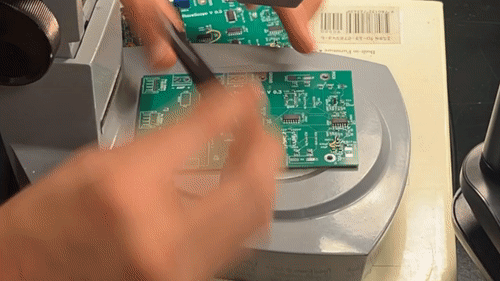Hi, I’m Adam
I’m an engineer, inventor, maker, artist, and musician based in London, UK. I’m passionate about sound, movement, and interaction with technology.
My research and creative practice focuses on creating robotic art and inventing/augmenting musical instruments.
I am a PhD student in Design Engineering at Imperial College London conducting research with the Augmented Instruments Lab. I received Bachelor’s Degrees in Sound Engineering and Electrical Engineering in 2022 and a Master’s in Performing Arts Technology in 2024, all at the University of Michigan.
Recent Highlights:
Electromagnetic Harpsichord (Work-in-progress)
The Electromagnetic Harpsichord is a collaboration with University of Michigan School of Music, Theatre & Dance Professor of Harpsichord Dr. Joseph Gascho.
Using optical sensing, analog signal processing, and Lorentz Force Actuation, we can sustain vibrations in brass harpsichord strings indefinitely. This piece was originally written for Musette, a predecessor to modern bagpipes, which famously hold and sustain drone notes. This composition is frequently performed on harpsichord, but the drone must be re-struck regularly. This emerging technology enables a modern update to classic repertoire.
Learn more about the working principles of this project on GitHub.
Flora (Floral, Length-Oscillating Robotic Apparatus)
FLORA is an animatronic designed for the stage and features flexible distributed control. In its stage debut in Asking Alice, FLORA represents the magic of wonderland. The animatronic was manually controlled by a remote operator in the first half and controlled by the dancer’s movement in the second half via inertial measurement unit (IMU) data.
FLORA was designed, invented, and built by Adam Schmidt and Jessica Carlson. Programmed with Arduino and controlled with Max/MSP, this robot was inspired by James Bruton’s Tentacle Robot and features 3 tiers of machined aluminum, each with (3) 20kG*cm servo motors. Flower arrangement by Jessica Carlson.
Lorentz Lap Brass
The Lorentz Lap Brass is a new Electromagnetically-Actuated Musical Instrument/Interface that utilizes the principles of electromagnetics and optics to sense, modulate, and generate vibrations in the instrument’s brass strings. The instrument exemplifies an affordable and accessible method for integrated sonic/haptic interaction via a low-cost setup that employs Lorentz Force Actuation. This style of actuation is not nearly as common as electromagnetic coils, though it presents a rich opportunity for cost-effective tactile feedback, infinite sustain, and feedback control in musical applications. Custom bridges with built-in optical transducers allow for sensing of the user’s interaction with the instrument’s two strings.
EyeWall
EyeWall was created with my sister Chelsea Schmidt. We built this playful and eerie piece of kinetic art to interfere with viewers’ sense of perception, self, and surveillance. The eyes initially invite you to look back, but eventually invite you to look within.
The Eyeballs were handcrafted by Chelsea - each eye was a new experiment using paints, papers, pigments, pearlescence and more to achieve unique effects. The eyeballs were then machined to fit 3D-printed mechanisms.
Will Cogley of Nilheim Mechatronics provided the STL files and original design that we edited, mangled, and redesigned to fit the needs of this project.
Software: Arduino and exported for Teensy 4.0. CAD: Fusion 360 and Blender.
GrooveWheel
This playful project was my first go at using the Inertial Measurement Unit (IMU) within my smart phone to capture human interaction and isolate specific gestures.
The phone transmits IMU/Gyroscope data to my computer via OSC with the GyrOSC app. Max/MSP receives this data and processes it to isolate gestures like spinning, twitches, and tilt of the phone. These gestures control the playback of pre-loaded audio samples.
This exercise brought to light the creative potential of the technology that I carry around my in my pocket everyday and has influenced later works. FLORA was an extension of using my phone’s IMU data to communicate with MAX/MSP and control media. Practicing how to use sensor readings to influence signal processing in realtime proved useful when developing the Lorentz Lap Brass.
Reaper’s Raptor
Reaper's Raptor blends traditional and modern metalsmithing techniques with robotics. The raven-inspired bird skull was sculpted with wax and then cast in bronze. Motorized linkages of brass and bronze animate an otherwise lifeless object.
The raven’s skull symbolizes ancient wisdom - calling upon traditional metal casting techniques that have been around for millenia. Raven skulls also symbolize intelligence, as its reanimation has been enabled by technical innovations and modern technologies that are still in their infancy (in comparison to ancient metallurgy and craft).



